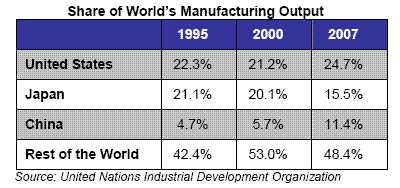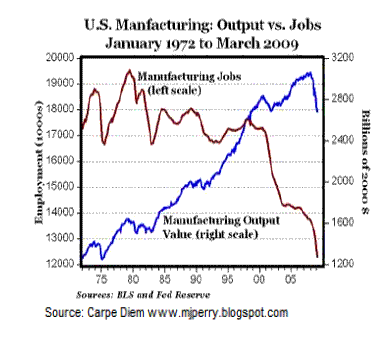 It makes the world’s savers reluctant to be exposed to the U.S. dollar.
It makes the world’s savers reluctant to be exposed to the U.S. dollar.Posted on 10/05/2009 4:25:24 AM PDT by expat_panama
The United States has been hollowed out. It no longer manufactures goods. Once the factory of the world, the U.S. now manufactures debt. The high wage manufacturing jobs have been out-sourced to low wage economies. The demise of U.S. manufacturing is at the core of the decline of America, its chronic trade deficits and growing international indebtedness. It makes the world’s savers reluctant to be exposed to the U.S. dollar.
It makes the world’s savers reluctant to be exposed to the U.S. dollar.
There is one problem with this widely held view: It is factually wrong.
The value of U.S. manufacturing output in real terms (adjusted for inflation) was a little more than $3 trillion in 2008. That is up from $1.2 trillion in 1972. If the U.S. manufacturing sector was a separate country, it would be the world’s 5th largest economy (behind the rest of the U.S., Japan, China and Germany). The U.S. remains the world’s largest manufacturer. Full stop.
 Although international comparisons are fraught with measuring problems, it appears that the U.S. share of world manufacturing is roughly the same as the combined total of the BRICs (Brazil, India and Russia account for a combined 11-12% share).
Although international comparisons are fraught with measuring problems, it appears that the U.S. share of world manufacturing is roughly the same as the combined total of the BRICs (Brazil, India and Russia account for a combined 11-12% share).
The data also suggests that the impressive rise of Chinese manufacturing has come at the expense of Japan and other East Asian countries more than the United States, which the UN data suggests actually saw a small rise of its global share in recent years.
China has largely injected itself into the production chain at the labor intensive stages, so that television or electronic good that may have been made in Japan or Taiwan or South Korea now says made in China.
[snip]
(Excerpt) Read more at realclearmarkets.com ...
The fact that people rarely take the last step is a strong indication that they can't challenge the new number on the basis of statistics or mathematics. Thus the simple, and transparent, efforts to create uncertainty without doing any work.
The question not discussed is exactly what products does the US manufacture now? And where are they manufactured?
The failure to do the 'simple' and transparent work to establish the validity of stats is on the front end, and lies with those who produce the stats. It's not the responsiblity of the general public to prove the validity of stats.
I recall the ridiculous graphs which plotted nothing but international trade as a percentage of GDP, and the conclusions that that proved Smoot-Hawley was some major factor in the Great Depression. In that case, practically any element of GDP could have been plotted against the total with the same result, or same trend line.
This practice of taking one element of GDP, and plotting it against the total over several decades, then claiming a definite valid relationship is nonsense. The relationship might be valid, but not because the statistical method was valid. There are far too many other factors involved.
Listen to yourself: the author of a study needs to anticipate all of the objections to it in advance, no matter how cockamamied they are? You have it backwards. The author presents his "evidence," and his challenger then presents his . . . one needs to follow the "yeah, but" argument with "here's why."
(And the reason you "recall" that graph is because it proves your premise wrong--you've never found anything similar to challenge it). Yeah but, yeah but, yeah but . . . but never proven.
All I'm saying is that, if you want to prove that Smoot-Hawley didn't contribute to the Great Depression, you have to show some numbers supporting the same . . . none of this, "yeah, but we all know the Earth is flat" (or "he was wrong about Mars") stuff.
I've been asking that for years.....
But I think the answer is obvious; go on the .gov dole.
You are far out in left field in all your responses. It is undeniable that when the elements which make up the denominator from which stats are generated are changing significantly, then the stats generated are of very questionable validity.
That is very much the case when any one element of years or decades because the various sectors of our economy which make up total GDP have changed so much since 1947.
And, you are trying to twist things around. I have stated, correctly, that these stats of one element of GDP compared to the total do not prove any valid relationship or causative factor. It does not follow, as you claim, that having proved a statistical method invalid, that I must also prove the claimed relationship to be invalid.
You must prove your claims to be valid by some valid method.
Why? Because food processing is notoriously a captive of the growing area, especially perishable items. Before the Feds cut the water off in the fertile areas of Cal there was a lot of ag mfg employment, from Napa to Bakersfield.
Not so much now, I think.
In addition, the national defense requires a strong base in “heavy” manufacturing, and these things don’t get turned back on in a day.
I agree that the transition is not inevitable. Too bad so many policy makers swallowed that crap over the last few decades. I think you make a mistake when you call our current system “capitalism”, which to me implies optimization rather than maximization, and an enlightened self-interest. In the “corporatist” world, profits must be maximized, and in the current permissive climate on M&A those who delay getting to the loan window end up bought and broken up by those who are swift. Creditors and employees end up paying the price, and control goes more and more to managerial elites.
I own a small manufacturing company. Here are my observations:
1. Regulation is killing our competitiveness. I spend 50% of my time meeting requirements from the Fire Dept., City, State, EPA, OSHA, et al. I have very expensive wallpaper (permits, training certificates, etc.) that covers an entire wall of my main office and costs thousands per year to renew.
2. Young Americans don’t want to do hard, hot, dirty work. My Foreman and I often bet on how many HOURS a new hire will work before quitting. All of my top workers are green card holders....Yes, we did get the BEST workers that Mexico had to offer. Don’t know about the recent immigrants.
3. Young Americans lack skills. I have never hired a high school grad who can convert fractions to decimals or multiply without a calculator. Nor can they spell or follow written process instructions.
4. We survive by our wits. Some of my competitors have massively automated to cut the labor out of the product cost. In my case, we offer very high quality and turn orders around in as little as 30 minutes. They cannot outsource that kind of service to China!
On the subject of the Great Depression, I just came across some graphs illustrating the change in GDP and the change in money supply. I believe that some external factors, such as government taxation and money supply can generate valid stats as a percentage of GDP. These aren’t stats, but are very interesting charts:
http://www.usstuckonstupid.com/sos_charts.php
The Fed caused the Great Depression, and prolonged it.
You have any data on these changes? Are you talking about products that are now counted as manufacturing that once were counted as something else?
| investigateworld obvious; go on the .gov dole. |
| SeeSharp They will work a lot less |
The way it works is that most people actually enjoy work, especially when they're doing something that others want so much that real money gets spent. OK, we always have sludge at the bottom that can't imagine going to all the trouble of thinking up a new line of work, but we've always had those types with us and fortunately they're a minority.
What's your point?
That certainly hasn't helped grow manufacturing, but as of 2006, we didn't have the work force for it anyway (remember the 4.6% unemployment rate?).
Even more than our less competitive stance, the overpriced doll has hurt manufacturing. When the dollar finally fell in 2007, our increase in manufactured goods gave us a net gain in GDP, just because our goods were cheaper overseas..
Japan and China consciously kept the dollar overvalued for years to lower the price of their exports.
Outsourcing has not failed, China and India are finally flexing some financial muscle, and have billions of people for a work force. It is only natural for labor intensive manufacturing to migrate to the lower labor costs.
That doesn't change the fact that the US manufactures as much as it always has, both in a percentage of our size, and in adjusted dollar amounts.
Probably starve and go naked, as they won’t be able to afford anything....without a job.
doll=dollar
...duh
I went to some garage/yard sales last week, and everything but two items were made in China....sad.
It's not clear how that would be different from the plot shown of the total dollar value of U.S. manufacturing output since 1970 adjusted for inflation.
Mfg. as percentage of GDP doesn’t tell us very much.
OK, but where does this come in?
Disclaimer: Opinions posted on Free Republic are those of the individual posters and do not necessarily represent the opinion of Free Republic or its management. All materials posted herein are protected by copyright law and the exemption for fair use of copyrighted works.